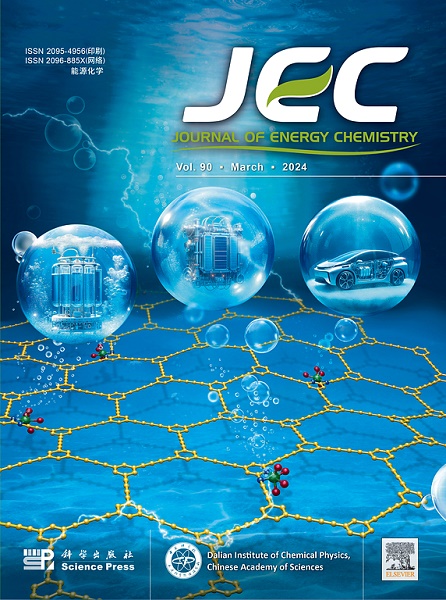Bioinspired sticker-type multilayer anti-reflective film for flexible perovskite solar cells
IF 13.1
1区 化学
Q1 Energy
引用次数: 0
Abstract
Perovskite solar cells (PSCs) have been receiving attention for photovoltaic advantages of high-power conversion efficiency, cost-effectiveness, and easy fabrication process. Particularly, flexible PSCs (FPSCs) are considered to be promising renewable power sources due to the positive potential of flexible and lightweight properties. However, FPSCs tend to have lower efficiency compared to glass-based rigid PSCs (RPSCs). The main issue is high refractive index of polymer substrates such as polyethylene naphthalate (PEN), used for FPSCs, thereby reducing the external light absorption efficiency. In this study, we developed glasswing inspired sticker-type multilayer anti-reflective (GSMA) film derived from the wings of the glasswing butterfly to enhance the light absorption efficiency of FPSCs. We designed and fabricated the GSMA film with multilayers specifically for FPSCs. The suitable materials and nanostructures to adjust the refractive index are theoretically optimized. The GSMA film effectively improved the optical properties of PSC substrates, reducing reflectance (∼5.01%) and enhancing light transmittance (∼6.17%) in indium tin oxide (ITO)/PEN. In addition, the GSMA film on PEN maintains more than 94.70% of its initial transmittance even after being exposed to various harsh environments for 500 h, and GSMA film demonstrates flexibility by maintaining its initial structure even after a bending test (bending radius of 1 mm). The FPSCs and RPSCs assisted by GSMA film show high short-circuit current density (FPSC: ∼25.28 mA/cm2, up to 26.05 mA/cm2, RPSC: ∼24.27 mA/cm2) and power conversion efficiency (FPSC: ∼22.72%, RPSC: ∼22.31%), significantly narrowing the efficiency gap between FPSC and RPSCs.

柔性钙钛矿太阳能电池的仿生贴式多层抗反射膜
钙钛矿太阳能电池(PSCs)以其高功率转换效率、高成本效益和易于制造的光伏优势而受到人们的关注。特别是柔性PSCs (FPSCs),由于其柔韧性和轻量化的积极潜力,被认为是有前途的可再生能源。然而,与玻璃基刚性psc (RPSCs)相比,FPSCs的效率往往较低。主要问题是用于fpsc的聚合物衬底(如聚萘二甲酸乙二醇酯(PEN))的高折射率,从而降低了外部光吸收效率。在这项研究中,我们开发了玻璃翼启发贴纸型多层抗反射(GSMA)膜,该膜来源于玻璃翼蝴蝶的翅膀,以提高FPSCs的光吸收效率。我们设计并制造了专门用于fpsc的多层GSMA薄膜。从理论上优化了调节折射率的合适材料和纳米结构。GSMA薄膜有效地改善了PSC衬底的光学性能,降低了氧化铟锡(ITO)/PEN的反射率(~ 5.01%),提高了透光率(~ 6.17%)。此外,PEN上的GSMA薄膜即使在各种恶劣环境下暴露500小时,也能保持其初始透光率的94.70%以上,并且即使在弯曲测试(弯曲半径为1 mm)后,GSMA薄膜也能保持其初始结构,显示出灵活性。GSMA薄膜辅助的FPSCs和RPSCs具有较高的短路电流密度(FPSC: ~ 25.28 mA/cm2,高达26.05 mA/cm2, RPSC: ~ 24.27 mA/cm2)和功率转换效率(FPSC: ~ 22.72%, RPSC: ~ 22.31%),显著缩小了FPSC和RPSCs之间的效率差距。
本文章由计算机程序翻译,如有差异,请以英文原文为准。
求助全文
约1分钟内获得全文
求助全文
来源期刊

Journal of Energy Chemistry
CHEMISTRY, APPLIED-CHEMISTRY, PHYSICAL
CiteScore
19.10
自引率
8.40%
发文量
3631
审稿时长
15 days
期刊介绍:
The Journal of Energy Chemistry, the official publication of Science Press and the Dalian Institute of Chemical Physics, Chinese Academy of Sciences, serves as a platform for reporting creative research and innovative applications in energy chemistry. It mainly reports on creative researches and innovative applications of chemical conversions of fossil energy, carbon dioxide, electrochemical energy and hydrogen energy, as well as the conversions of biomass and solar energy related with chemical issues to promote academic exchanges in the field of energy chemistry and to accelerate the exploration, research and development of energy science and technologies.
This journal focuses on original research papers covering various topics within energy chemistry worldwide, including:
Optimized utilization of fossil energy
Hydrogen energy
Conversion and storage of electrochemical energy
Capture, storage, and chemical conversion of carbon dioxide
Materials and nanotechnologies for energy conversion and storage
Chemistry in biomass conversion
Chemistry in the utilization of solar energy
 求助内容:
求助内容: 应助结果提醒方式:
应助结果提醒方式:


